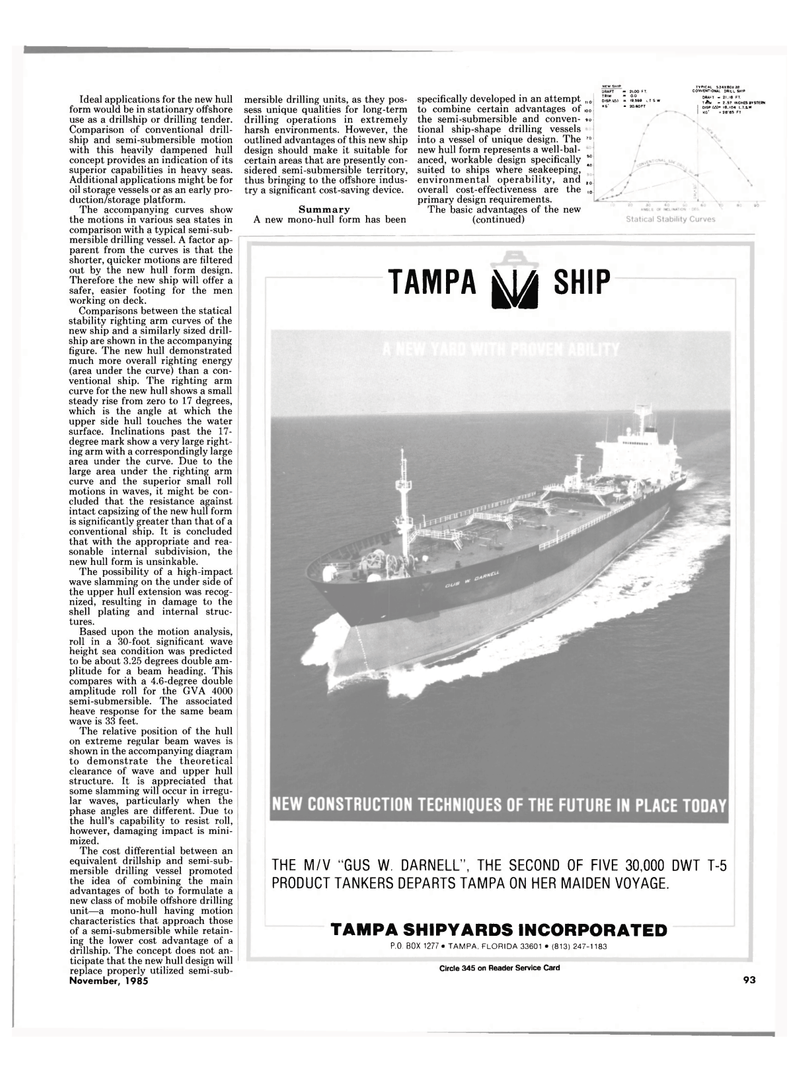
Page 87: of Maritime Reporter Magazine (November 1985)
Read this page in Pdf, Flash or Html5 edition of November 1985 Maritime Reporter Magazine
Ideal applications for the new hull form would be in stationary offshore use as a drillship or drilling tender.
Comparison of conventional drill- ship and semi-submersible motion with this heavily dampened hull concept provides an indication of its superior capabilities in heavy seas.
Additional applications might be for oil storage vessels or as an early pro- duction/storage platform.
The accompanying curves show the motions in various sea states in comparison with a typical semi-sub- mersible drilling vessel. A factor ap- parent from the curves is that the shorter, quicker motions are filtered out by the new hull form design.
Therefore the new ship will offer a safer, easier footing for the men working on deck.
Comparisons between the statical stability righting arm curves of the new ship and a similarly sized drill- ship are shown in the accompanying figure. The new hull demonstrated much more overall righting energy (area under the curve) than a con- ventional ship. The righting arm curve for the new hull shows a small steady rise from zero to 17 degrees, which is the angle at which the upper side hull touches the water surface. Inclinations past the 17- degree mark show a very large right- ing arm with a correspondingly large area under the curve. Due to the large area under the righting arm curve and the superior small roll motions in waves, it might be con- cluded that the resistance against intact capsizing of the new hull form is significantly greater than that of a conventional ship. It is concluded that with the appropriate and rea- sonable internal subdivision, the new hull form is unsinkable.
The possibility of a high-impact wave slamming on the under side of the upper hull extension was recog- nized, resulting in damage to the shell plating and internal struc- tures.
Based upon the motion analysis, roll in a 30-foot significant wave height sea condition was predicted to be about 3.25 degrees double am- plitude for a beam heading. This compares with a 4.6-degree double amplitude roll for the GVA 4000 semi-submersible. The associated heave response for the same beam wave is 33 feet.
The relative position of the hull on extreme regular beam waves is shown in the accompanying diagram to demonstrate the theoretical clearance of wave and upper hull structure. It is appreciated that some slamming will occur in irregu- lar waves, particularly when the phase angles are different. Due to the hull's capability to resist roll, however, damaging impact is mini- mized.
The cost differential between an equivalent drillship and semi-sub- mersible drilling vessel promoted the idea of combining the main advantages of both to formulate a new class of mobile offshore drilling unit—a mono-hull having motion characteristics that approach those of a semi-submersible while retain- ing the lower cost advantage of a drillship. The concept does not an- ticipate that the new hull design will replace properly utilized semi-sub-
November, 1985 mersible drilling units, as they pos- sess unique qualities for long-term drilling operations in extremely harsh environments. However, the outlined advantages of this new ship design should make it suitable for certain areas that are presently con- sidered semi-submersible territory, thus bringing to the offshore indus- try a significant cost-saving device.
Summary
A new mono-hull form has been specifically developed in an attempt ,10. to combine certain advantages of ,<,<, the semi-submersible and conven- mo- tional ship-shape drilling vessels into a vessel of unique design. The 70 new hull form represents a well-bal- anced, workable design specifically ^ suited to ships where seakeeping, environmental operability, and 20. overall cost-effectiveness are the ,.„. primary design requirements.
The basic advantages of the new (continued) "OS"'"
DBAFT - 2I.OO F T.
TRIM = 0.0
DISP.1AI = 19,569 i-TSW
KG' - 20.60 FT 93
TAMPA yj SHIP
THE M/V "GUS W, DARNELL", THE SECOND OF FIVE 30,000 DWT T-5
PRODUCT TANKERS DEPARTS TAMPA ON HER MAIDEN VOYAGE.
TAMPA SHIPYARDS INCORPORATED
P.O. BOX 1277 • TAMPA, FLORIDA 33601 • (813) 247-1183
Circle 345 on Reader Service Card
TYPICAL 534X80X32
CONVENTIONAL DRILL SHIP
DRAFT - 21.18 FT.
Tr^M =2.57 INCHES BYSTERN
I DISP fA1= 18,104 L.T.S.W.
I KG' = 28!85 FT

 86
86

 88
88
